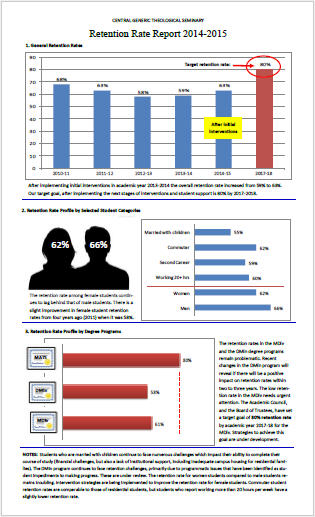
Ten curriculum assessment tools every dean needs. Part 7: Program Retention and Completion Rates Report
Theological school deans are not just theological leaders for their institution, they must be EDUCATIONAL leaders. That is, they must implement sound educational practices related to curriculum, instruction, supervision, assessment, and administration. There is a variety of ways to assess the effectiveness of the curriculum, and there are several levels of assessment (program-level, course-level, student testing, student projects, etc.). While faculty members can focus on course-level and individual student learning assessment, academic deans need to focus on program-level assessment in order to evaluate the effectiveness of the school's curricular course of study. Here are ten basic curriculum assessment tools every academic dean needs:

Outcomes alignment worksheet
Syllabus assessment worksheet
Curriculum maps
Program-level rubrics
Alumni survey
Grade Distribution report
Program retention and completion rate worksheets
Entering student profile
Graduating class profile
Student course evaluations
In this series we review these ten assessment tools. This month:
7. Program Retention and Completion Rates Report.
I once conducted a consultation with a theological school facing numerous challenges. Prior to the consultation they identified various issues they wanted to focus on during the visit, including their declining enrollment. They provided data and information I asked for in anticipation of the meeting. However, one piece of data was missing from the the list I'd asked them to provide: the student retention rate.
Their student retention rate was not a data point they tracked, and, it was not a metric they used for program evaluation. Upon examining the data of their student and programs retention rates, they discovered they retained only 58% of the students to program completion. Furthermore, the low retention rate for their "bread and butter" degree program was enough to show there was something troubling that needed attention. They not only had a recruitment and enrollment challenge, they had a student retention problem.
Retention refers to the ability of a school to retain students through degree completion. Historically, it is a major concern for most colleges and universities, and arguably, more so for theological schools. Student retention rates and related issues can be evaluated from two perspectives: students and programs.
Student Retention
Student retention focuses on those factors related to individual students, or groups of students, who are at risk for leaving the program before completion. The factors to evaluate include:
- Identifying academically high risk students
- Assessing the level of support provided for academically at risk students
- Evaluating the effectiveness of interventions provided for at risk students
- Evaluating the timeliness and effectiveness of faculty feedback about at risk students
- Evaluating the effectiveness of the school's student services, procedures, and policies related to academically at risk students
- Evaluating student services and support related to non-academic challenges faced by students
- Identifying financial challenges.
Your school will be helped in addressing the above issues if you can identify and track indicators of student risk and "flag" them early. Those can include things like habitual absences and lateness to classes, difficult classroom performance or behaviors, late payments to the business office, academic probation, and social challenges.
Another helpful practice is to identify the qualities and competencies that make for a "successful" student in your programs of study. This will help you design and apply a predictive model that can help you design a plan for success for at risk students. This facet helps shift the focus from merely retaining high risk students to promoting academic success.
Program Retention
A second way to assess retention issues is to look at retention in particular degree programs. A school should be aware to what extent issues related to the degree program of study itself contributes to retention challenges, aside from more personal and individual student issues. Things to consider include:
- Course schedules (Too cumbersome? Too inconvenient? Unrealistic? Not enough options?)
- Degree program requirements (Too many unnecessary components?)
- Program costs (Too high? Not competitive enough? Too many fees?)
- Accessibility (Not enough options in course formats? Not flexible enough? Insufficient accommodation to student needs?)
- Program structure (Too complicated? Too many parts? Too cumbersome?)
- Perceived program value (Can people easily weigh program cost against program value? Is the program meaningful? Does it address actual needs?)
- Program marketability (Is it easily recognizable? Will it lead to a job or career goal? Is it legitimate?)
Documenting and Reporting

As with any assessment and evaluation practice, disseminating the information and insights is critical to using data for improvement. Below is an example of the retention report from the mythical Central Generic Theological Seminary. The dean provides this report at strategic times to prompt review and responses by administration, staff, and faculty in addressing retention challenges. In this report, the dean depicts retention rates by student and degree programs. The dean also shows how particular student segments impact the student retention rates. You can download a copy of the report here. Download Retentionratereport
Israel Galindo is Associate Dean, Lifelong Learning at the Columbia Theological Seminary. Galindo writes for the "Along the Journey" blog of the Columbia Theological Seminary, and, the Digital Flipchart blog. His most recent books are Mastering the Art of Instruction: The Nine Essential Instructional Skills Every Teacher Must Master, Stories of the Desert Fathers: Wit And Wisdom for Today's Bewildering Times, Seeking the Holy: An Introduction to the History and Practice of Spiritual Direction for Today's Churches, and Theories of Learning: Approaches to Teaching and Learning for Christian Educators and Theological Faculty